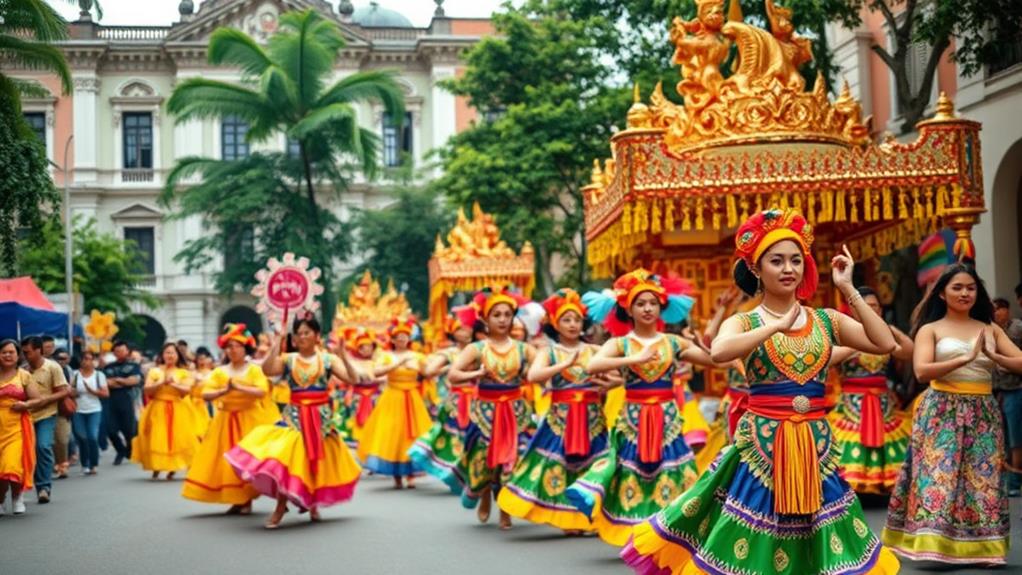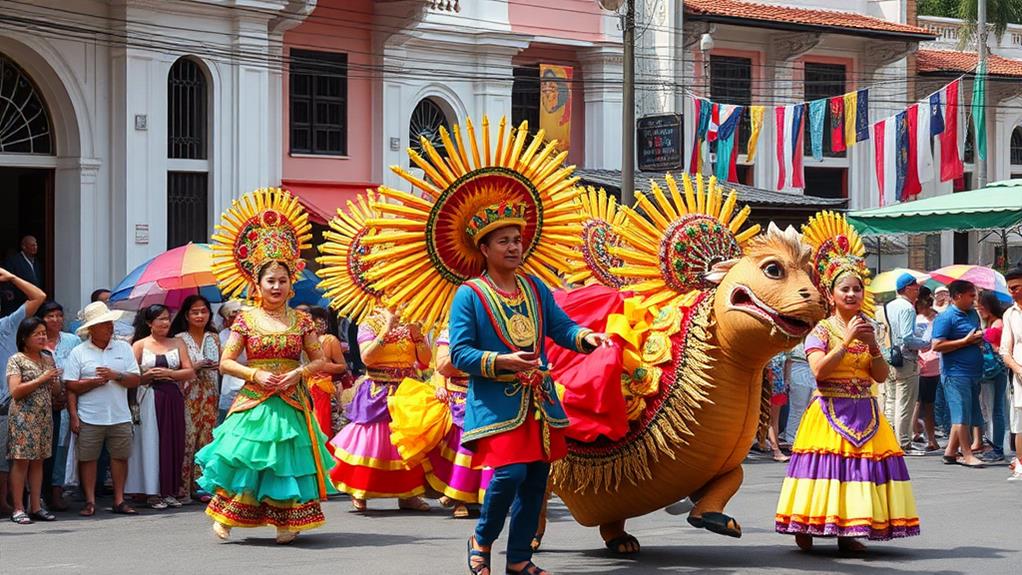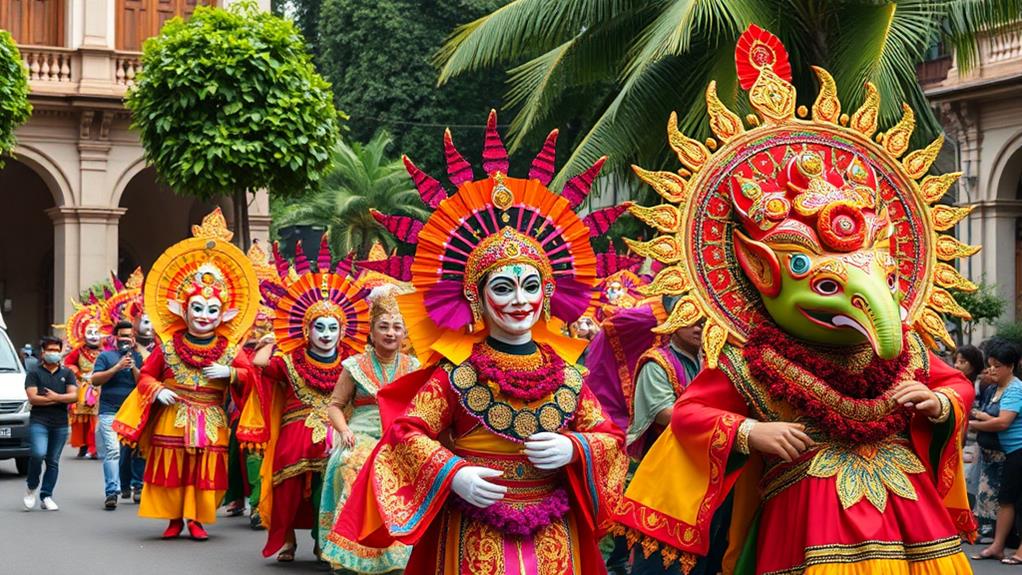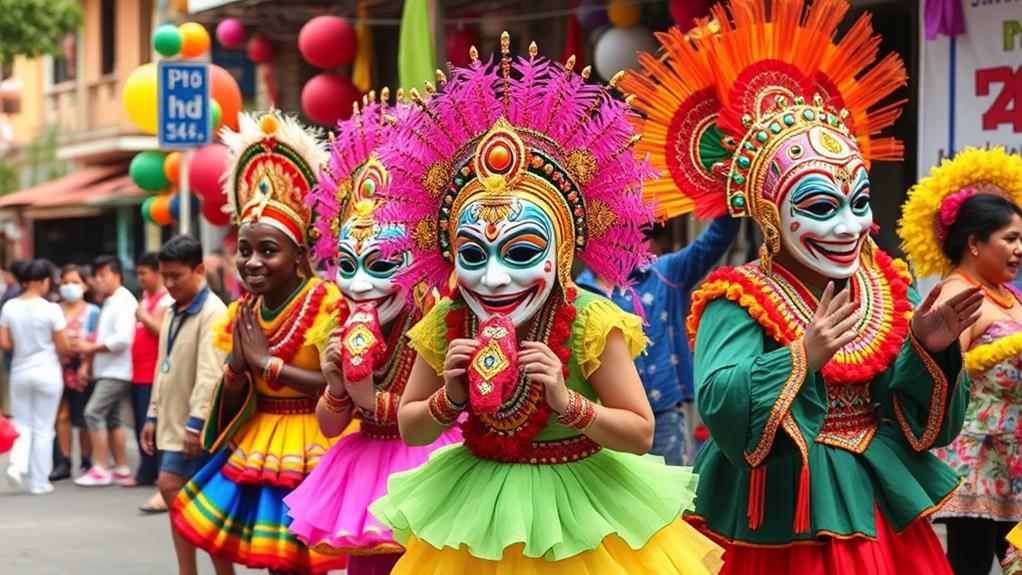The Philippines is home to numerous cities that showcase its vibrant cultural heritage through traditional festivals. Cebu, Kalibo, Baguio, Davao, and Iloilo are the top cities to experience these unique celebrations.
In Cebu, the Sinulog Festival is a major event that honors Santo Niño, a significant figure in the country's history. This festival features street dancing and colorful costumes.
Kalibo, on the other hand, hosts the Ati-Atihan Festival, which showcases face painting and street dancing. This event is a celebration of the city's history and cultural heritage.
In Baguio, the Panagbenga Festival is a highlight, featuring stunning flower floats that showcase the city's creativity and artistry.
Davao and Iloilo also have their own unique festivals. The Kadayawan Festival in Davao highlights indigenous culture and traditions, while Iloilo's Dinagyang Festival offers a glimpse into the city's rich heritage.
Discovering Filipino Cultural Heritage

The Philippines is home to a diverse array of cultural festivals, with over 42,000 major and minor celebrations taking place throughout the year.
These festivals showcase the country's unique traditions and heritage, often featuring vibrant street dancing, colorful costumes, and traditional music. For example, the Sinulog Festival in Cebu and the Ati-Atihan Festival in Kalibo are two major festivals that pay homage to Santo Niño.
The Pahiyas Festival in Lucban, Quezon, on the other hand, focuses on gratitude for bountiful harvests through homes decorated with rice and agricultural products.
The Philippines' cultural festivals blend indigenous practices with Spanish colonial influences, resulting in a unique cultural identity. This blending of traditions is evident in the festivals, which often combine traditional music and dance with Spanish colonial-era influences.
For instance, the use of Spanish-era costumes and props is common in many festivals, while traditional Filipino instruments, such as the kulintang, are often used to accompany the dancing.
Attending these festivals provides a deeper understanding of the country's history, traditions, and values. By immersing oneself in these celebrations, one can gain insight into the country's rich heritage and the importance of community spirit and local arts and crafts.
Top Festival Destinations in Philippines
The Philippines' vibrant cultural festivals are concentrated in several key cities. These cities are top destinations for experiencing the country's rich heritage.
One of the most notable festival destinations is Cebu City, which hosts the renowned Sinulog Festival. This grand festival draws over a million attendees each year. The Sinulog Festival features vibrant street performances and grand parades celebrating Santo Niño.
Other notable festival destinations in the Philippines include cities that host unique and culturally significant events. Bacolod City is famous for the Masskara Festival, a celebration of the city's resilience. This festival is marked by colorful masks, street dances, and food stalls.
Meanwhile, Baguio City's Panagbenga Festival showcases the city's vibrant culture through colorful flower floats and street dancing.
These festivals offer a glimpse into the country's rich cultural heritage. Each festival provides a unique experience, from street dance performances to grand parades. This makes them a great way to immerse yourself in the country's cultural traditions.
Cities to Experience Traditional Festivals

The Philippines is a country rich in cultural heritage, with each city hosting unique traditional festivals.
Some top cities to visit for these festivals include:
- Cebu City is home to the Sinulog Festival. This grand celebration takes place every third Sunday of January and features street dancing and vibrant parades that honor Santo Niño.
- Iloilo City hosts the Dinagyang Festival. This celebration occurs from January 13-22 and features competitive street dancing and cultural performances that honor Santo Niño.
- Baguio City celebrates the Panagbenga Festival in February. This festival is a stunning display of flower floats and street dancing that draws over a million visitors each year.
- Davao City hosts the Kadayawan Festival in the third week of August. This festival highlights the region's rich indigenous heritage through colorful parades and street dance competitions.
Each city offers a unique festival experience that showcases the country's vibrant culture and warm hospitality.
Vibrant Parades and Street Performances
The Philippines is home to numerous vibrant festivals featuring parades and street performances. These events showcase the country's rich cultural heritage and are a great way to experience its unique blend of indigenous and modern culture.
The Sinulog Festival in Cebu City is a prime example, attracting up to a million people every third Sunday of January with its grand parade featuring traditional costumes and street performances. The festival's grand parade is a highlight, showcasing the city's cultural heritage.
Similarly, the Masskara Festival in Bacolod City, celebrated every fourth Sunday of October, is known for its lively street dances featuring participants in colorful masks.
Other notable festivals include the Kadayawan Festival in Davao City, the Ati-Atihan Festival in Kalibo, Aklan, and the Panagbenga Festival in Baguio City. These events offer a glimpse into the Philippines' rich cultural heritage through vibrant street dancing and colorful floats.
For instance, the Kadayawan Festival features vibrant parades with flower floats and traditional street dance competitions during the third week of August.
Exploring Rich Cultural Traditions

The Philippines' Vibrant Festivals Offer a Glimpse into Its Rich Cultural Traditions.
Festivals in the Philippines are more than just lively parades and street performances; they provide a unique look into the country's history, customs, and traditions. Each city has its own distinct cultural heritage.
Some notable cities celebrated for their cultural heritage include:
- Cebu City's Sinulog Festival Honors Santo Niño with Vibrant Street Parades. The festival showcases the city's rich cultural heritage through colorful parades and street performances.
- Kalibo's Ati-Atihan Festival Promotes Local Traditions and Community Spirit. This festival, one of the oldest in the Philippines, celebrates the city's heritage through music, dance, and costumes.
- Bacolod City's Masskara Festival Features Colorful Masks and Lively Street Dancing. The festival symbolizes resilience and joy through its vibrant masks and street performances.
- Davao City's Kadayawan Festival Showcases Indigenous Culture and Bountiful Harvests. The festival promotes local heritage and community engagement through colorful parades, food fairs, and cultural performances.
Unique Festival Experiences in Philippines
The Philippines is a country known for its vibrant festivals, which showcase its rich cultural heritage. These festivals offer a glimpse into the country's history, traditions, and values. Each festival has its unique character, from street parties to solemn processions, reflecting the country's creativity and resilience.
Philippine festivals vary throughout the year, with different events taking place in different months. Some notable festivals include:
| Festival | Date | Description |
|---|---|---|
| Sinulog Festival | January | A festival featuring vibrant street parades and cultural performances honoring Santo Niño |
| Ati-Atihan Festival | Third Sunday of January | A lively dance and street party to celebrate the patron saint |
| Pahiyas Festival | May 15 | Colorful decorations made from rice and agricultural products |
| Panagbenga Festival | February | A grand float parade and street dancing to celebrate the blooming season |
| Kadayawan Festival | Third week of August | Grand parades, floral floats, and food fairs to honor indigenous culture |
These festivals provide a unique experience for visitors, allowing them to immerse themselves in local culture and traditions. For example, the Sinulog Festival offers a vibrant street party, while the Ati-Atihan Festival provides a lively dance experience. The Philippines' festivals are a reflection of its rich heritage, attracting visitors from around the world.
Must Visit Cities for Festival Lovers

The Philippines is a prime destination for festival lovers, boasting numerous cities that host unique and captivating celebrations.
Four must-visit cities for festival enthusiasts are Cebu City, Kalibo, Baguio City, and Davao City.
Cebu City hosts the Sinulog Festival, a vibrant event that attracts over a million attendees annually with its colorful parades and street dancing. This festival showcases the city's rich cultural heritage and is a significant event in the country's festival calendar.
Kalibo, Aklan, is famous for its historic Ati-Atihan Festival, which features face painting and lively processions that highlight the city's cultural roots. This festival is a testament to the city's rich history and cultural diversity.
Baguio City celebrates the Panagbenga Festival, a spectacular event that brings the city to life with flower floats and street dancing, drawing over a million visitors annually. This festival is a celebration of the city's vibrant culture and natural beauty.
Davao City is known for its Kadayawan Festival, a joyous celebration that features parades, street dancing, and food fairs that attract both local and international tourists. This festival is a showcase of the city's rich cultural heritage and its warm hospitality.
Immersing in Philippine Festival Culture
Philippine Festivals Showcase the Country's Rich Cultural Heritage
The Philippines is home to numerous vibrant festivals that reflect its diverse cultural landscape. Each celebration offers a unique glimpse into the country's traditions and customs.
Unique Traditions and Customs
The Sinulog Festival in Cebu City honors Santo Niño with parades and cultural performances. In contrast, the Ati-Atihan Festival in Kalibo, Aklan, showcases traditional dance and music.
These festivals allow visitors to experience the country's diverse cultural heritage firsthand.
Celebrations of Indigenous Culture
The Kadayawan Festival in Davao City is a celebration of indigenous culture, featuring colorful parades and street dancing. Similarly, the Masskara Festival in Bacolod City features street dancers in colorful masks, symbolizing resilience and joy.
These festivals promote a deeper understanding of the country's cultural heritage.
Festivals as a Celebration of Life, Tradition, and Community
The Panagbenga Festival in Baguio City, also known as the Flower Festival, boasts stunning flower floats and lively street performances.
By attending these festivals, visitors gain a deeper understanding of the Philippines' rich cultural heritage and create unforgettable memories.
Attending Philippine festivals is a celebration of life, tradition, and community.
Questions and Answers
What Is the Festival Capital of the Philippines?
Cebu City is the Festival Capital of the Philippines. This title is attributed to the city's vibrant cultural heritage, showcased through various festivals.
The Sinulog Festival is a prominent example, celebrated every third Sunday of January. This festival showcases the city's rich cultural heritage through street dancing and traditional attires.
What Is the Top 1 Festival in the Philippines?
The Sinulog Festival is the top festival in the Philippines. This festival outshines others in the country, including the Ati Atihan, Pahiyas, Panagbenga, Kadayawan, Obando, and Malasimbo festivals. The Sinulog Festival is known for its massive Grand Parade, which showcases the country's rich cultural heritage.
What Is the Philippines Most Popular Cultural Venue?
The Philippines' most popular cultural venue is the Sinulog Cultural Center in Cebu City.
You'll find this cultural hub in Cebu City, which is known for its rich cultural heritage. The city offers a mix of vibrant traditional music, local cuisine, and lively folk dances, such as the Sinulog Festival dance, alongside art exhibitions and unique indigenous crafts near historical landmarks.
Which City Is Known as the Queen of All Festivals in the Philippines?
Cebu is known as the "Queen of All Festivals" in the Philippines. This title is primarily due to its vibrant Sinulog Festival, which attracts large crowds and showcases the city's rich cultural heritage. The Sinulog Festival rivals other major festivals in the Philippines, such as the Ati-Atihan Festival in Kalibo and the Pahiyas Festival in Lucban.